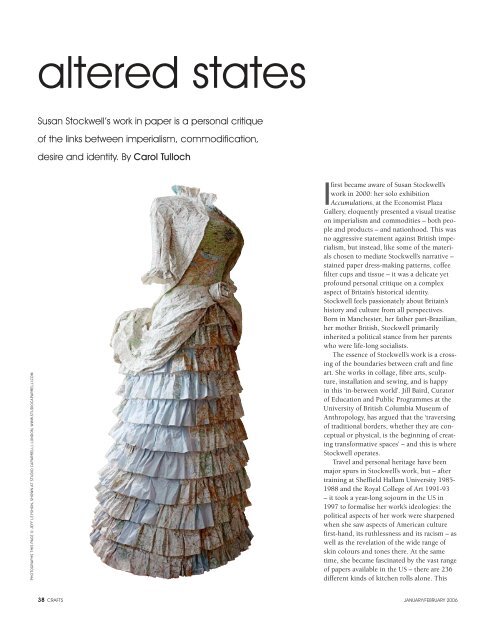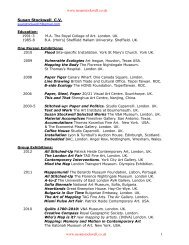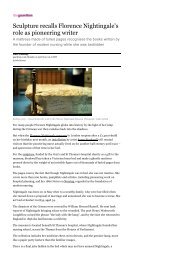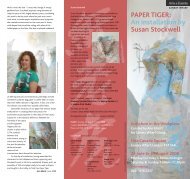altered states - Susan Stockwell
altered states - Susan Stockwell
altered states - Susan Stockwell
Create successful ePaper yourself
Turn your PDF publications into a flip-book with our unique Google optimized e-Paper software.
<strong>altered</strong> <strong>states</strong><strong>Susan</strong> <strong>Stockwell</strong>’s work in paper is a personal critiqueof the links between imperialism, commodification,desire and identity. By Carol TullochPHOTOGRAPHS THIS PAGE © JEFF LEYSHON, SHOWN AT STUDIO CAPARRELLI, LONDON, WWW.STUDIOCAPARRELLI.COMIfirst became aware of <strong>Susan</strong> <strong>Stockwell</strong>’swork in 2000: her solo exhibitionAccumulations, at the Economist PlazaGallery, eloquently presented a visual treatiseon imperialism and commodities – both peopleand products – and nationhood. This wasno aggressive statement against British imperialism,but instead, like some of the materialschosen to mediate <strong>Stockwell</strong>’s narrative –stained paper dress-making patterns, coffeefilter cups and tissue – it was a delicate yetprofound personal critique on a complexaspect of Britain’s historical identity.<strong>Stockwell</strong> feels passionately about Britain’shistory and culture from all perspectives.Born in Manchester, her father part-Brazilian,her mother British, <strong>Stockwell</strong> primarilyinherited a political stance from her parentswho were life-long socialists.The essence of <strong>Stockwell</strong>’s work is a crossingof the boundaries between craft and fineart. She works in collage, fibre arts, sculpture,installation and sewing, and is happyin this ‘in-between world’. Jill Baird, Curatorof Education and Public Programmes at theUniversity of British Columbia Museum ofAnthropology, has argued that the ‘traversingof traditional borders, whether they are conceptualor physical, is the beginning of creatingtransformative spaces’ – and this is where<strong>Stockwell</strong> operates.Travel and personal heritage have beenmajor spurs in <strong>Stockwell</strong>’s work, but – aftertraining at Sheffield Hallam University 1985-1988 and the Royal College of Art 1991-93– it took a year-long sojourn in the US in1997 to formalise her work’s ideologies: thepolitical aspects of her work were sharpenedwhen she saw aspects of American culturefirst-hand, its ruthlessness and its racism – aswell as the revelation of the wide range ofskin colours and tones there. At the sametime, she became fascinated by the vast rangeof papers available in the US – there are 236different kinds of kitchen rolls alone. This38 CRAFTS JANUARY/FEBRUARY 200638 CRAFTS MAY/JUNE 2003
susan stockwellTHIS PAGE and OPPOSITE: ‘Empire Dress’,recycled Michelin and Ordnance Survey maps,glue, wire frame, 2005JANUARY/FEBRUARY 2006 CRAFTS 39
susan stockwell‘TRAYNE’ PHOTOGRAPH © DAVE MORGAN/’IMPERIAL QUILT’ PHOTOGRAPH © THE ARTISTABOVE: ‘Trayne’, used paper coffee filters, coffee-stained portion cups stitched with cotton thread, 2000OPPOSITE PAGE: ‘Imperial Quilt’ and detail, recycled paper maps, cotton thread, 2.3 x 2.2 m, 2005interest in materials led to such pieces asTrayne (2000), a bustled strapless gown madefrom stained coffee filters of different shades– reflecting what she calls the ‘stains of existence’.<strong>Stockwell</strong> is currently artist in residenceat the Shenghua Arts Centre, Nanjing,China, where she has returned to her explorationof ranges of paper types.<strong>Stockwell</strong> does not produce or use apattern for a work; as a sculptor, she worksdirectly with the material. The paper dressmakingpatterns are reserved for a furtherdimension of critique of imperialism, colonialism;the construction of new pieces, newworlds – pieces and worlds to be ‘stitchedup’, their presence reduced or expandedaccording to who controls whom. For example,in Pattern of the World – acquired by theWord and Image Department of the Victoriaand Albert Museum in 2002 – <strong>Stockwell</strong>painted onto paper dress patterns whichhad been pinned together to create herbase ‘canvas’, a map of the world in tea,to represent Asia and Europe, and coffeein reference to Africa and the Americas.More recently, <strong>Stockwell</strong> has expanded herrepertoire to include quilts. She sees quiltingas ‘symbolic of the connections betweenwomen’; in her own case, her connectionwith her quilt-making grandmother. Quiltingalso has a tradition of recycling, the potentialto recycle history linking neatly with hervisual plays with maps. Quilting can be ametaphor for ‘diversity and political correctness’:the stitching together of materials canbe read as ‘connection-making, unificationand harmonising’. Her Imperial Quilt – firstshown in her 2005 solo show Stitched-Up:Paper and Politics, at Studio Caparrelli,London – tests such thinking. She describesthis piece as beautiful yet disturbing: amap of the world has been cut into small40 CRAFTS JANUARY/FEBRUARY 2006
susan stockwellseven-centimetre patchwork squares andreconfigured by hand-sewing the piecestogether. The US makes up the border; otherpieces are scattered strategically. Most pertinently,the Middle East and Washington DCare placed at the centre of the quilt, underliningthe pervasive presence of AmericanImperialism. Imperial Quilt is also about massmemory, a reminder of the millions roundthe world who demonstrated against theimpending war in Iraq – <strong>Stockwell</strong> attendedthe London mass march in February 2003,the diverse throng of women, men and childrena human quilt joined together by angerand frustration at the imminent conflict.<strong>Stockwell</strong>’s current work appears to departfrom political commentary, instead exploringromance and desire. But this shift is no greatleap for <strong>Stockwell</strong>, who argues that ‘Love andpolitics are part of the same thing — look atDavid Blunkett. Most love affairs are politicaland politics is about desire and aspirations. Ithink that my work is not just about oneaspect.’ Not yet shown to the public, thesculpture BedBook (2005), as it is tentativelynamed, developed out of the Pulp FantasyQuilt – a piece composed of Mills and Booncovers linked by long hand-sewn stitches –made for the exhibition Pulp Fantasy in 2005.In BedBook, Mills and Boon page proofs fill theapertures of an iron bedstead, found discardedin Kings Cross. Some of the titles – MedicinalLove and The Perfect Husband – are visible,evoking readers’ hopes; love, intimacy andpassionate romance, graphically located wheresuch feelings are most often acted upon: inbed. <strong>Stockwell</strong> admits that she embarked onPulp Fantasy Quilt with an ironic eye, but asshe read and worked with the books moreclosely, her attitude became more considered.Jay Dixon, author of The Romance Fiction ofJANUARY/FEBRUARY 2006 CRAFTS 41
susan stockwellMills and Boon, 1909-1990s, has defendedwhat she considers this much-maligned genreof popular fiction, reassessing it from a feministperspective. Mills and Boon women, since1909, have been represented as taking controlof their own lives and that of their men,engaging in pre and extra-marital sex: ‘Thehome,’ writes Dixon, ‘is the place of femininepower into which the hero must be brought.’Rosemary Auchmuty, a specialist in 19th and20th-century feminist history agrees, arguingthat the underlying message in Mills and Boonis that ‘women can change men throughlove… to meet women’s standards.’ BedBookand Pulp Fantasy Quilt both explore this territory– after all, what better tools to discusssuch issues than a quilt and a bed, complexsymbols of home life and relationshipsencouraging new readings of the concept oflove, sexual encounters and the home.One wonders if deeper links can be madebetween the Mills and Boon world, and suchpieces as Trayne. Perhaps we can invoke postcolonialtheory, in the shape of African textiles.Historian Jessica Hemmings’s claim that‘the intersection between nation and individualcontinues to search for a balance betweenthe burden of the past and the demands ofthe hybrid present.’ Certainly <strong>Stockwell</strong> isnot the only artist to situate work in this territory– think of Yinka Shonibare’s GayVictorians, two Victorian-style bustled dressesusing ‘traditional’ West African fabrics.Colonialism and imperialism forcibly dispersedpeople from parts of Africa, via slavery,to European colonies – and while differentparts of the African diaspora remain connectedthrough this history, there have beenenormous cultural transformations amongthe constituent parts. Within this discourse,and reflecting it, <strong>Stockwell</strong> has made personalidentity less of a concern in her workthan the pursuit of authenticity of self.In complex times – when myriad formsand forces drive cultural process – onething that can be sincere is the agency ofthe maker/artist. All of which, for <strong>Stockwell</strong>,represents further aspects of her interestin the ‘stains of existence’, and her curiosityabout the places in between.<strong>Susan</strong> <strong>Stockwell</strong> shows in Conversations, a groupshow at the Ambrosino Gallery, 769 NE 125thSt, North Miami, USA, (001) 305 891 5577, fromMarch-May 2006 (dates to be confirmed), whereshe will be in conversation with Korean-Americanartist Jean Shin; and in a solo show at 20-21 VisualArts Centre, St John’s Church, Church Square, Scunthorpe,Lincolnshire DN15 6TB, (01724) 297070,in October 2006 (dates to be confirmed).42 CRAFTS JANUARY/FEBRUARY 2006







